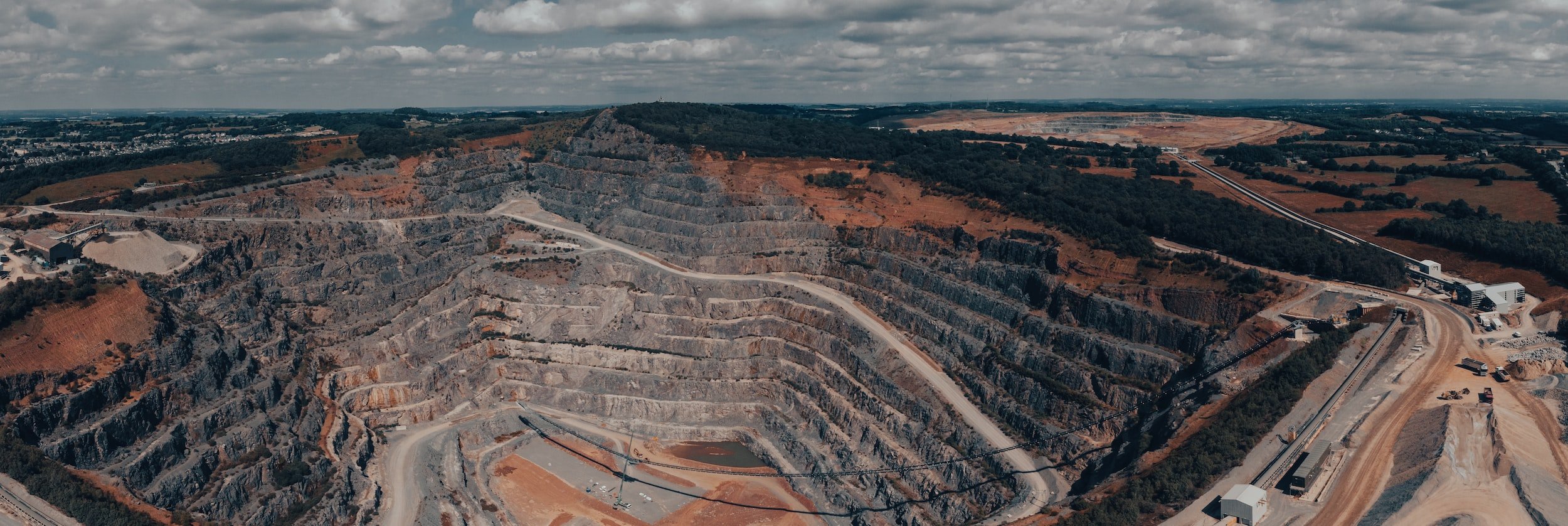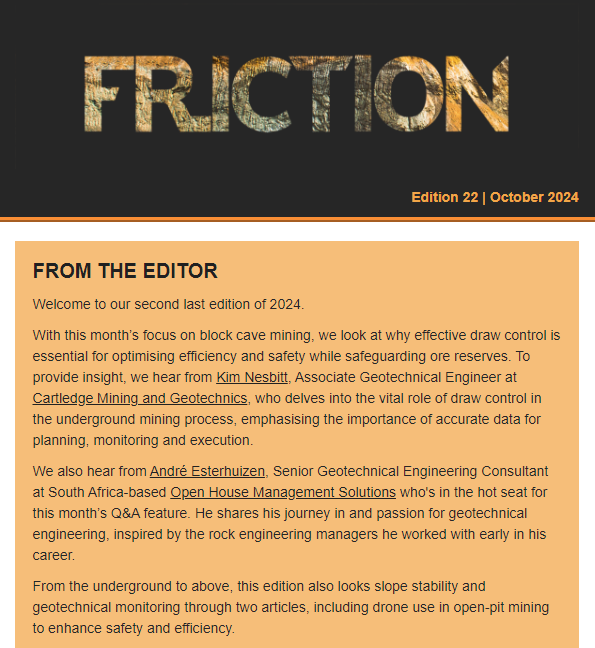
Friction: Edition 23 | November 2024
Throughout 2024, Friction has continued to be a trusted resource for geotechnical professionals, providing global insights into the critical challenges and advancements within our industry.
The importance of building a robust geotechnical program
Mine site safety depends on many factors, with a crucial component being a robust geotechnical program. Tim Cartledge, Principal Consultant at Cartledge Mining and Geotechnics, recently spoke to delegates about this topic at the Mongolia Mining 2024 International Mining Expo, held in the natural-resource rich developing country. In this article, he shares his expertise on why robust geotechnical plans are so vital, what’s at stake when there are shortfalls and how the industry can implement solid plans and embrace opportunities to drive towards a safer future.
Friction: Edition 22 | October 2024
Welcome to our second last edition of 2024. With this month’s focus on block cave mining, we look at why effective draw control is essential for optimising efficiency and safety while safeguarding ore reserves.
Q&A with André Esterhuizen
This month we unearth the hidden layers of South Africa-based André Esterhuizen, Senior Geotechnical Engineering Consultant at Open House Management Solutions.
From the importance of data collection and evolving with technology to his perspective as a geo-professional in South Africa, André shares profound insight into his experience as a geotechnical engineer and the entire industry.
The importance of draw control in block cave mining operations
Draw control is a critical aspect of block cave mining operations. In this article, Kim Nesbitt, Associate Geotechnical Engineer at Cartledge Mining and Geotechnics, explores how draw control plays a pivotal role in ensuring the efficiency, safety and viability of the large-scale underground mining process and the importance of accurate data in planning, monitoring and execution.
Friction: Edition 21 | September 2024
Welcome to September. As we transition to the business end of the year, we turn our attention to a critical area of our industry: tailings dam rehabilitation. In this edition, Senior Geotechnical Engineer, Ahmad Zarei of Cartledge Mining & Geotechnics highlights the innovative methods emerging in the management and safety of tailings dams. He shares his perspective on the cutting-edge approaches being used in tailings dam management, which prioritise both environmental responsibility and long-term structural integrity.
Innovative approaches to tailings dam rehabilitation: The importance of addressing environmental and structural risks
Tailings dam rehabilitation is a complex task requiring both technical expertise and innovative solutions. These large structures, holding millions of cubic metres of mining waste, present significant environmental and societal risks if not managed properly. Here, Senior Geotechnical Engineer, Ahmad Zarei delves into the evolving methods used to safely rehabilitate tailings dams, exploring cutting-edge approaches that balance environmental responsibility with long-term structural stability.
Friction: Edition 20 | August 2024
Welcome to August! This month, we delve into the varying standards of geotechnical education and training around the globe.
Australian geotechnical engineers are fortunate to operate in an advanced industry, with ample access to resources, technology and development opportunities. But not every resource-rich nation is the same. With a shortage of engineers coming through, there is a significant need to address advancement in training geotechnical engineers in resource-rich developing countries, to ensure a thriving industry globally.
Unearthing a global challenge: Training and advancing geotechnical engineers in resource-rich developing countries
When it comes to training and developing geotechnical engineers, the global playing field is anything but level. Natural-resource-rich developing countries face compounding challenges, extending from resources, facilitation of formal programs and funding, to talent attraction and retention, often with complex cultural systems also at play.
Cartledge Mining and Geotechnics Principal Consultant Tim Cartledge explores this globally significant issue, with insights from Senior Lecturer Jannie Maritz from the University of Pretoria, South Africa.
Friction: Edition 19 | July 2024
We are officially past the halfway point of 2024 and so far in Friction we have covered everything from Corporate Governance to Safety in Design to Numerical Modelling and Laboratory Testing. For this edition, we dive into raiseboring and how geotechnical investigation and thorough assessment is essential to reducing uncertainty and risk in the process, but must occur without compromising how findings are delivered.
Deep diligence before the dig: How thorough geotechnical investigation lifts raiseboring safety and efficiency concerns
Raiseboring – creating a vertical shaft into underground mine pits without explosives – is conceptually straightforward. In practice, however, it can be a complex story, with many factors including location ground condition and structure, projected service lifespan and other engineering considerations at play.
In this article, Phillip Quinn, Cartledge Mining and Geotechnics Senior Geotechnical Engineer, explores the process and how thorough geotechnical investigation, in collaboration with all stakeholders, can greatly improve a raiseboring project’s safe completion.
Friction: Edition 18 | June 2024
Good governance encompasses not only the system by which organisations are controlled, but the mechanisms by which organisations and those who comprise them are held to account.
This month we dive deep into corporate governance framework and look at the crucial role the board of governance plays in navigating sustainability, risk management and legislative requirements.
Q&A with Phil Dight
Like a geologist chipping away, let's unearth the hidden layers of Phil Dight, Professor of Geotechnical Engineering, Australian Centre for Geomechanics, The University of Western Australia, by asking all the important questions.
From the importance of geology in engineering to his passion for teaching, Phil shares profound insight on his experience and the industry, through the lens of a Professor in the specialised field.
Corporate Governance: Mining geotechnics and the storage of tailings
From the planning and design phases to closure and rehabilitation, corporate governance has significant impacts throughout the entirety of a mine’s life cycle. So, it is important that we, as geotechnical engineers, understand the structures behind corporate governance to best achieve compliance.
In this piece, Wouter Hartman explores how governments and regulators are striding towards a more sustainable and safe future for the mining industry, through the improved regulatory, compliance and risk management processes that underpin how a corporation conducts its business. Wouter also shares his knowledge on common corporate governance structures.
Friction: Edition 17 | May 2024
Safety and mining go hand in hand. With the majority of work being performed in high-pressure environments for long hours at a time and in remote locations, there are a number of factors to consider when thinking about the health, safety and well-being of all on site.
In this month’s edition, we explore the importance of incorporating safety in design and why safety measures must be featured prominently throughout the entirety of a project, from concept to closure.
Q&A with David Reid
People are the bedrock of our industry, so let’s get to know David Reid, Research Fellow at The University of Western Australia. This month, we ask him the important questions from how he got his start in the sector to the advice he’d give to up and coming geotechnical professionals.
Safety in Design in Geotechnical Engineering
Design optimisation is frequently front of mind when designing a mining project. However, in an industry with a high potential of risk, it is of the utmost importance that we, as geotechnical engineers, place higher value on incorporating safety measures in the design process to ensure the safety of workers on a mine site.
Scott Lines, Senior Geotechnical Engineer at Red Earth Engineering, discusses how safety must be prioritised in every phase of operations, including from the conceptual to the detailed design phase, and provides key tips on how to incorporate the essential safety measures in design to best prepare for the common pitfalls.
Friction: Edition 16 | April 2024
As geotechnical engineers, structural geology is at the very core of everything we do. This month, I personally dive into the importance of structural geology and why it’s imperative we look at the rocks first.
Q&A with Michael Munro
Like a geologist inspecting all rock discontinuity, let's unearth the hidden layers of Michael Munro, Technical Director at GMEK, by asking the important questions in our monthly Q&A feature.
First things first, just look at the rocks
For geotechnical engineers, it’s easy to go straight for the detail, the data, and pour energy into what’s perceived, and known, to work best. In this article, Cartledge Mining and Geotechnics Director Tim Cartledge explores the simple yet often overlooked process of stepping away from the desk, getting out on site and just looking at the rocks – adding another dimension to the benefits of numerical modelling – to gain the fullest picture of what’s really going on.




















